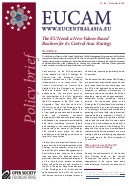The EU’s Humanitarian Aid and Civil Protection Policy in Central Asia: Past Crises and Emergencies to Come
The EU’s Humanitarian Aid and Civil Protection Policy in Central Asia: Past Crises and Emergencies to Come
Author(s): Bruno De Cordier
Subject(s): Human Rights and Humanitarian Law, Civil Society, Government/Political systems, International relations/trade, Politics and law, Politics and society, Social development, Sociology of Politics
Published by: CEPS Centre for European Policy Studies
Keywords: European Union; humanitarian help; civil protection policy; Central Asia; crisis; politics;
Summary/Abstract: The 2007 EU Strategy for Central Asia stresses security and stability through regional cooperation and integration, poverty reduction and good governance. But the strategy hardly mentions humanitarian aid, a security-related activity that not only plays a crucial role in strengthening European soft power in crisis-affected areas, but also predates many of the European Union’s programmes in the Central Asian region. Between 2007 and 2012, the region’s governments requested foreign aid for a dozen humanitarian emergencies. The majority were floods, earthquakes and so-called compound crises caused by exceptionally cold winters, a breakdown in energy supply and the reduction of winter crop yields and livestock. The same period also saw a political emergency with serious communal violence, displacement and habitat destruction. In one way or another, these crises affected around 4.5 million people out of a total population of some 58 million. These emergencies clearly reflect the hazard risks continually faced by the Central Asian region due to its physical and human geography as well as its sociopolitical legacies and dynamics.
Series: EUCAM - Policy Brief
- Page Count: 7
- Publication Year: 2013
- Language: English
- Content File-PDF

